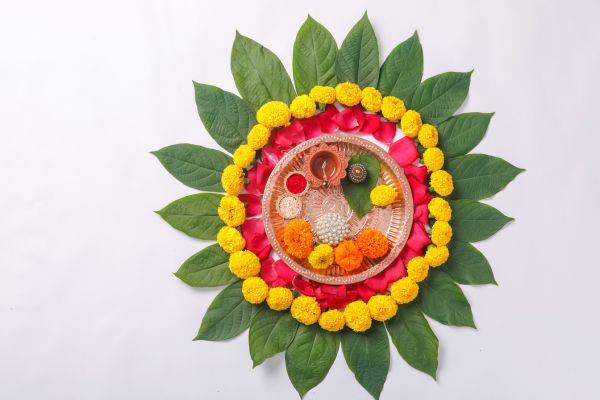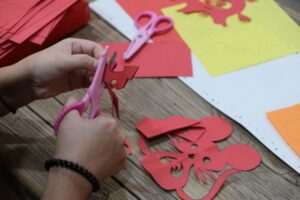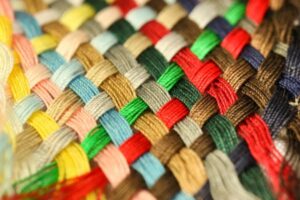Indian culture is rich with vibrant traditions, and one of the most captivating and visually stunning is the art of Rangoli. Rangoli is a form of decorative art created on the floors of homes, courtyards, and temples using colorful powders, rice, flowers, or other materials. It holds deep cultural significance and is an integral part of festive celebrations, religious rituals, and auspicious occasions. In this article, we will explore the captivating world of Indian Rangoli art, its historical roots, symbolism, techniques, and its enduring significance in Indian culture.
1: Historical Origins of Rangoli: A Timeless Tradition
1.1 Ancient Beginnings: Tracing Rangoli’s Roots
Rangoli has a rich and ancient history that can be traced back to the Indus Valley Civilization, around 2500 BCE. Excavations have revealed intricate patterns and designs similar to modern-day Rangoli, suggesting that this art form has been an integral part of Indian culture for millennia.
1.2 Regional Variations: Rangoli Across India
Rangoli is practiced throughout India, with each region adding its own unique flair and style. From the geometric patterns of North India to the intricate floral designs of South India, the diversity of Rangoli reflects the vibrant cultural tapestry of the country.
1.3 Influence of Folklore and Mythology: Stories in Colors
Rangoli often draws inspiration from Indian folklore, mythology, and religious symbols. It is not uncommon to see Rangoli designs depicting gods, goddesses, mythical creatures, and scenes from ancient epics, such as the Ramayana and Mahabharata. These designs not only add beauty but also serve as visual narratives, connecting people to their cultural heritage.
2: Techniques and Materials Used in Rangoli Art
2.1 Powdered Colors: Vibrant Hues of Celebration
Traditionally, Rangoli was created using natural materials like colored powders derived from rice, turmeric, vermilion, and flowers. Today, synthetic powders are also used, offering a wider range of vibrant colors and ease of use. These powdered colors are skillfully arranged and spread on the ground or a base to form intricate patterns and motifs.
2.2 Rice: Symbolism and Purity
In certain regions, Rangoli is made using rice grains. The use of rice holds symbolic significance, representing fertility, prosperity, and purity. The rice grains are meticulously arranged to form patterns, creating stunning visuals that enhance the sacredness of the art form.
2.3 Flower Petals: Fragrance and Delicacy
Flower petals are another popular material used in Rangoli, especially during religious ceremonies and festivals. The vibrant colors and fragrant essence of fresh flower petals create a sensory experience, and their delicate nature adds an ethereal quality to the artwork.
3: Symbolism and Significance of Rangoli Art
3.1 Welcoming the Divine: Rangoli as an Invitation
Rangoli is often created at the entrance of homes, temples, and other sacred spaces as a way to welcome deities and guests. The symmetrical patterns and vibrant colors are believed to invite positive energies and prosperity into the space, setting the stage for auspicious beginnings.
3.2 Auspicious Symbols: Attracting Good Fortune
Rangoli designs often incorporate auspicious symbols such as lotus flowers, swastikas, peacocks, and elephants. These symbols are believed to bring good luck, prosperity, and harmony to the household and are carefully arranged to evoke positive energies and blessings.
3.3 Cultural Identity and Unity: Rangoli as a Unifying Art Form
Rangoli serves as a unifying art form, bringing communities together during festivals and celebrations. People from different backgrounds and walks of life gather to create Rangoli designs, fostering a sense of cultural identity, harmony, and social cohesion.
4: Traditional Rangoli Patterns and Designs
4.1 Kolam: Auspicious Patterns of South India
Kolam, a form of Rangoli prominent in South India, features intricate geometric patterns and symmetrical designs. Rice flour is commonly used to create Kolam, and the art form has become an integral part of daily life and cultural festivities in the region.
4.2 Alpana: Bengali Artistry
Alpana, practiced predominantly in Bengal, is a refined form of Rangoli that showcases intricate and elaborate designs. Using a mix of powdered rice, clay, and flowers, Bengali women create Alpana designs during festivals and weddings, adorning their homes and courtyards with stunning patterns.
4.3 Chowkpurana: Traditional Rangoli of Rajasthan
Rajasthan, known for its vibrant culture, is home to Chowkpurana, a distinctive style of Rangoli. The designs feature bold geometric shapes and intricate motifs that reflect the region’s rich artistic heritage. Chowkpurana is often created using vibrant colors, making it visually striking and captivating.
5: Contemporary Adaptations of Rangoli Art
5.1 Rangoli in Modern Art: Exploring New Frontiers
Contemporary artists have embraced Rangoli as a medium for artistic expression and experimentation. They incorporate the traditional techniques and motifs of Rangoli into mixed-media artworks, installations, and even digital designs, pushing the boundaries of the art form and bridging the gap between tradition and innovation.
5.2 Rangoli in Fashion and Design: Weaving Tradition into Contemporary Aesthetics
The vibrant colors, patterns, and intricate details of Rangoli have inspired designers to incorporate elements of the art form into fashion, textiles, and home decor. From embroidered motifs to Rangoli-inspired prints, these adaptations celebrate the beauty and cultural significance of Rangoli in contemporary contexts.
5.3 Rangoli as a Form of Expression: Individual Creativity and Personal Style
Rangoli has also become a means for individuals to express their creativity and personal style. Artists and enthusiasts experiment with new designs, color combinations, and techniques, infusing their unique perspectives and interpretations into their Rangoli creations, further evolving the art form.
6: Rangoli Festivals: Celebrating Color and Creativity
6.1 Diwali: Illuminating the Path with Rangoli
During the festival of Diwali, Rangoli takes center stage as homes and streets are adorned with intricate designs. The vibrant patterns and lit diyas (oil lamps) create a mesmerizing atmosphere, symbolizing the triumph of light over darkness and inviting prosperity and happiness into homes.
6.2 Pongal: Harvesting Joy with Rangoli
Pongal, a harvest festival celebrated in South India, is marked by the creation of colorful Rangoli designs using rice flour. The Rangoli patterns, often depicting the sun, cows, and other symbols of abundance, pay homage to the bountiful harvest and express gratitude for nature’s blessings.
7: Passing Down the Art of Rangoli: From Generation to Generation
7.1 Family Traditions: Learning Rangoli from Elders
The art of Rangoli is often passed down through generations within families. Elders teach younger family members the techniques, patterns, and symbolism associated with Rangoli, fostering a sense of cultural continuity and familial bonds.
7.2 Rangoli Workshops and Classes: Nurturing New Talent
Various organizations and educational institutions offer Rangoli workshops and classes, providing opportunities for individuals of all ages to learn and master the art form. These initiatives not only preserve the traditional techniques but also encourage innovation and the exploration of personal creativity.
8: Rangoli Competitions: Showcasing Artistic Excellence
8.1 State and National Rangoli Competitions: Celebrating Talent
Rangoli competitions are held at various levels, from local to national, providing a platform for artists to showcase their skills and creativity. These competitions bring together talented individuals from different regions, fostering healthy competition and celebrating the diversity of Rangoli art.
9: Rangoli as Community Engagement: Unity and Collaboration
9.1 Rangoli Workshops and Community Events: Bringing People Together
Community events and workshops centered around Rangoli provide opportunities for people to come together, learn, and create art collectively. These events promote community engagement, cultural exchange, and foster a sense of belonging and unity.
9.2 Collaborative Rangoli Projects: Bridging Divides and Encouraging Dialogue
Collaborative Rangoli projects involving individuals from different backgrounds and communities promote social harmony and dialogue. By working together to create large-scale Rangoli designs, participants learn from one another, celebrate diversity, and build bridges of understanding.
10: Rangoli in Contemporary Art and Design: Fusion of Tradition and Modernity
10.1 Rangoli-Inspired Art Installations: Blending Past and Present
In the realm of contemporary art and design, Rangoli serves as a constant source of inspiration for artists seeking to bridge the gap between tradition and modernity. Rangoli-inspired art installations are emerging as powerful visual expressions that celebrate the cultural heritage of India while pushing the boundaries of artistic innovation. These installations often employ a range of materials, including vibrant powders, illuminated elements, and unconventional mediums, to create immersive experiences that captivate audiences.
10.2 Rangoli-Influenced Graphic Design: Adapting Tradition to Digital Mediums
In the digital age, Rangoli has also found its place in the world of graphic design. Designers incorporate Rangoli motifs, patterns, and color schemes into their digital artwork, infusing traditional elements into modern visual communication. From logo designs to digital illustrations, Rangoli-inspired graphic design embraces the harmonious balance of intricate details and vibrant colors, creating visually striking and culturally significant designs.
10.3 Rangoli-Inspired Fashion: Ornamenting the Human Canvas
Fashion designers are drawn to the intricate patterns and vibrant colors of Rangoli, incorporating them into clothing, accessories, and even body art. Rangoli-inspired fashion showcases the fusion of traditional craft and contemporary aesthetics, with designers using embroidery, prints, and innovative techniques to capture the essence of Rangoli in wearable art. These creations not only pay homage to the cultural significance of Rangoli but also allow individuals to adorn themselves with the beauty and symbolism of this ancient art form.
Conclusion
The art of Rangoli continues to transcend time, evolving and adapting to contemporary expressions of creativity. As it finds its place in the realms of art, design, and fashion, Rangoli embraces the spirit of fusion, seamlessly blending tradition and modernity. These contemporary interpretations celebrate the rich cultural heritage of Rangoli, serving as a reminder of its enduring significance in Indian society. As Rangoli-inspired art installations, graphic designs, and fashion creations capture the imagination of global audiences, the colorful tradition of Rangoli finds new avenues to inspire, delight, and connect people across boundaries. May the fusion of tradition and modernity in Rangoli continue to ignite the creative spirit and keep this ancient art form alive for generations to come.



